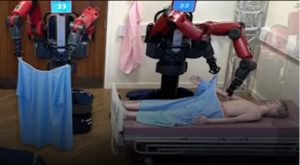More Hospitals are Having Robots Fill in for Nurses Suffering from Burnout
 Millions of nurses all over the U.S. are being stretched to their breaking points as they’re asked to take on more patients. The ongoing nursing shortage isn’t getting any better as healthcare workers increasingly suffer from burnout and fatigue. But some providers are getting help from an unlikely source. Robots are starting to fill in the gaps when there aren’t enough nurses to go around, and some providers say they are thankful for the help.
Millions of nurses all over the U.S. are being stretched to their breaking points as they’re asked to take on more patients. The ongoing nursing shortage isn’t getting any better as healthcare workers increasingly suffer from burnout and fatigue. But some providers are getting help from an unlikely source. Robots are starting to fill in the gaps when there aren’t enough nurses to go around, and some providers say they are thankful for the help.
An Extra Pair of Hands
If you visit Mary Washington Hospital in Fredericksburg, Virginia, you will see the nurses working alongside a robot named Moxi. It’s six feet tall with two electronic eyes and a multi-jointed arm that can pick up items from various angles. The built-in camera helps Moxi avoid objects and patients as it navigates the halls. It is usually busy bringing medications, equipment, and personal supplies to providers on nearly every floor, but it has to ask a human for help to use the elevator. Nurses can call the robot via text message or assign it a task using a nearby kiosk.
Abigail Hamilton, a nurse at Mary Washington, said she appreciates the extra pair of hands. She said it can add an extra 30 minutes to her day by saving her a trip to the basement or fifth floor to get supplies.
This is just one of several robots being implemented in healthcare settings. Moxi has been roaming the halls of some of the largest hospitals in the country since the start of the pandemic.
It was developed by Diligent Robotics, and the first commercial model was deployed about a month into the pandemic. There are now about 15 Moxi robots working in hospitals all over the U.S., with an additional 60 scheduled to launch later this year.
“In 2018, any hospital that was thinking about working with us, it was a special project for the CFO or innovation project about the hospital of the future,” said Diligent Robotics CEO Andrea Thomaz. “What we saw over the last two years is that almost every single health care system is thinking about robotics and automation or has robotics and automation on their strategic agenda.”
Most robots are being used to transport and deliver healthcare supplies, but others are tasked with disinfecting entire wards and assisting physical therapists.
According to a recent survey of nurses that work alongside delivery robots like Moxi, around half expressed concern that these robots could pose a risk to their jobs, but Moxi isn’t exactly a caregiver. This technology still has a long way to go before nurses have reason to worry about their jobs.
There are still a few kinks to work out as well. During early trials at a hospital in Houston, TX, researchers noted that Moxi often required staff oversight when it came to supply chain management. For example, the robot isn’t equipped to read expiration dates.
Cybersecurity experts say these kinds of machines can also be a vulnerability. Security firm Cynerio recently exposed a security vulnerability in the delivery robot Tug that allows hackers to remotely take control of the machine. No similar vulnerabilities have been detected in Moxi, but Diligent Robotics says it continues to monitor the system for potential threats.
Most of the nurses surveyed about Moxi said that it gave them more time to talk to patients when they were being discharged from the hospital.
Others said Moxi saved them energy, brought joy to patients and their families, and ensured that patients always had water when it was time for them to take their medication.
“I could do it faster, but it’s better for Moxi to do it so I can do something else more useful,” said one of the nurses that participated in the survey.
Others complained that Moxi often had trouble navigating tight or cramped spaces, especially during busy times. Some nurses said the robot couldn’t anticipate patient needs because it lacked access to electronic health records. Others said patients became suspicious of “the robot’s eyes recording them.”
The authors of the original study on Moxi concluded that it is best suited for low-risk tasks. Diligent Robotics is currently working on a way to integrate Moxi’s software program with electronic health records to help it stay in sync with patients and providers.
Moxi has already logged 600 hours of work time at Mary Washington.
“As a society, we’re not who we were in February 2020,” said Hamilton. “We have to think of different ways to support caregivers at the bedside.”
Dressing a Mannequin
Moxi isn’t the only robot making headlines in the healthcare industry. Researchers Fan Zhang and Yiannis Demiris at Imperial College in London recently demonstrated how their robot nurse can dress a mannequin lying in bed. The robot participated in a scenario that closely resembles the part of the Certified Nursing Assistant test where providers have to put an open-back robe on a person that is partially paralyzed.
Robots often struggle to grasp and handle flexible objects like fabric and clothing because their shape and dimensions can be hard to predict, but Demiris and Zhang developed a way for the robot to handle objects at a fixed point.
The two men taught the robot how to dress a mannequin using its built-in artificial intelligence system. They worked out the kinks before letting the robot participate in the trial. The results showed the robot fully dressed the mannequin while in bed 90.5% of the time.
Mehmet Dogar, of the University of Leeds, U.K., said the robot completed the task by identifying key spots on the garment and focusing on a set point. “When you’re putting your own shirt on, putting your hand through the sleeve, you don’t exactly know where the rest of the garment is, right?” he said.
The robot might be able to put a robe on a mannequin but working with human patients is another matter entirely.
“These are very specific feasibility studies we’re looking at, and nurses are much, much more than that,” Dogar said. “If you got this robot and put it in a real hospital, even just for this task, it will fail many times due to variations in the problem. So, I don’t think we can say robotic nurses are near, but these are all research questions that we need to ask and investigate so that we can move towards that.”
(This story originally appeared in Scrubs Magazine.)




